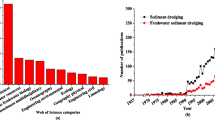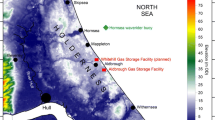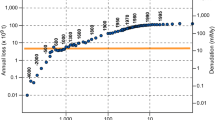Abstract
By wind tunnel experiment, we studied the deflation rates of 8 different clastic sediments in the arid regions of China, discussed the sources of aeolian sand and their influence on the development of sand dunes and formation of sand deserts from the view of dynamics of wind erosion. The average deflation rates of 8 typical clastic sediments in the arid regions of China can be arranged in the order of lacustrine sand > alluvial sand > weathered sandstone and shale > pluvial sediments > fluvioglacial sand > weathered granite > slope deposit > glacial sediments. The deflation rates exhibited strong positive correlations with the erodible particle (0.063–2mm) content and sorting features. In contrast, the deflation rates had obvious negative correlations with the contents of silt clay (<0.063 mm) and gravel (>2 mm). According to the deflation rates, the 8 typical clastic sediments can be divided into four categories: (1) lacustrine and alluvial sand, which are readily prone to wind erosion, assumed to be the main source of aeolian sand; (2) weathered sandstone and shale, pluvial sediments and fluvioglacial sand with considerable deflation rates, might be the secondary source of aeolian sand; (3) weathered granite and slope deposit having the lower deflation rates, could supply a little aeolian sand; and (4) glacial sediments with a strong anti-erodibility, could hardly offer any aeolian sand. In addition to the strong wind conditions, the exposure of extensive lacustrine sand induced by the desiccation of inland lake basin, as well as the pre-sorting of clastic sediments by flowing water should be the key factors influencing the development of sand deserts in China. The possible reason the sand deserts in China being mostly distributed around the inland lake basins and along riverbanks could be better understood through sand source analysis.
Similar content being viewed by others
References
Bagnold R A, 1941. The Physics of Blown Sand and Desert Dunes. New York: William Morrow & Company, 264–268.
Chepil W S, 1942. Measurement of wind erosiveness of soils by the dry sieving procedure. Scientific Agriculture, 23(3): 154–160.
Chepil W S, 1945. Dynamics of wind erosion: I. nature of movement of soil by wind. Soil Science, 60(4): 305–320.
Cooke R, Warren A, Goudie A, 1993. Desert Germorphology. UCL Press, 31–46.
Ding Zhongli, Sun Jimin, Liu Dongsheng, 1999. Sediment index of coupling relation during contacting desert-loess evolution. Science in China (Series D), 29(1): 82–87.
Dong Guangrong, Li Changzhi, Jin Jiong et al., 1987. Some results of wind tunnel experiment on wind erosion. Chinese Science Bulletin, 32(4): 297–301.
Dong Z B, Chen W N, Dong G R et al., 1995. Quantitative relationship between soil erosion by wind and surface structure destruction. Chinese Science Bulletin, 40(1): 54–57.
Embleton C, King C A M, 1975. Glacial Geomorphology. New York: John Wiley and Sons, 55–69.
Folk R L, Ward W C, 1957. Brazos River Bar: a study in the significance of grain size parameters. Journal of Sedimentary Petrology, 27(1): 3–26.
Gao Shangyu, Chen Weinan, Jin Heling et al., 1993. Preliminary research on the desert evolution in northwest of monsoon region of China since Holocene. Science in China (Series B), 23(2): 202–208.
Gillette D A, 1980. Major contributions of natural primary continental aerosols: source mechanisms. In: Kneip T J and Lioy P J (eds.), Aerosols: Anthropogenic and Natural, Sources and Transport. Annals of the New York Academy of Sciences, 338: 348–358.
Lancaster N, 1995. Geomorphology of Desert Dunes. London: Routledge, 290 pp.
Liu L Y, Wang J H, Li X Y et al., 1998. Determination of erodible particles on cultivated soils by wind tunnel simulation. Chinese Science Bulletin, 43(19): 1646–1651.
Liu Xianwan, 1995. Experimental Aeolian Physics and Technology. Beijing: Science Press, 43–50.
Logie M, 1981. Wind-tunnel experiments on sand dunes. Earth Surface Processes, 6(3–4): 365–374.
Petrof M II, 1959. The mineral element and origin of sand in the Ordos, east Alxa and middle valley of Huanghe River. Acta Geographica Sinica, 25(1): 1–20. (in Chinese)
Pye K, 1987. Aeolian Dust and Dust Deposition. Academic Press, 68pp.
Pye K, Tsoar H, 1990. Aeolian Sand and Sand Dunes. London: Unwin Hyman, 369–396.
Sidorenko A B, 1962. The Origin and Research Method of Desert Geomorphology. Beijing: Science Press, 73–81.
Skidmore E L, Powers D H, 1982. Dry soil-aggregate stability: energy-based index. Soil Science Society of America Journal, 46(6): 1274–1279.
Wu Zheng, 1987. Aeolian Geomorphology. Beijing: Science Press, 2–6.
Wu Zheng, Ling Yuquan, 1965. Some rules of blown sand movement and the preliminary insight of blown sand control. In: Team of CAS on Blown Sand Control: Research on Blown Sand Control (No. 7). Beijing: Science Press, 7–14.
Author information
Authors and Affiliations
Corresponding author
Additional information
Foundation: National Natural Science Foundation of China, No.40471014; The Ministry of Science and Technology, No.2005BA517A-11
Author: Song Yang (1978–), Ph.D., specialized in soil erosion and arid environment.
Rights and permissions
About this article
Cite this article
Song, Y., Liu, L., Li, X. et al. Deflation rates of different clastic sediments in the arid regions of China. J GEOGR SCI 16, 495–501 (2006). https://doi.org/10.1007/s11442-006-0414-6
Received:
Accepted:
Issue Date:
DOI: https://doi.org/10.1007/s11442-006-0414-6




